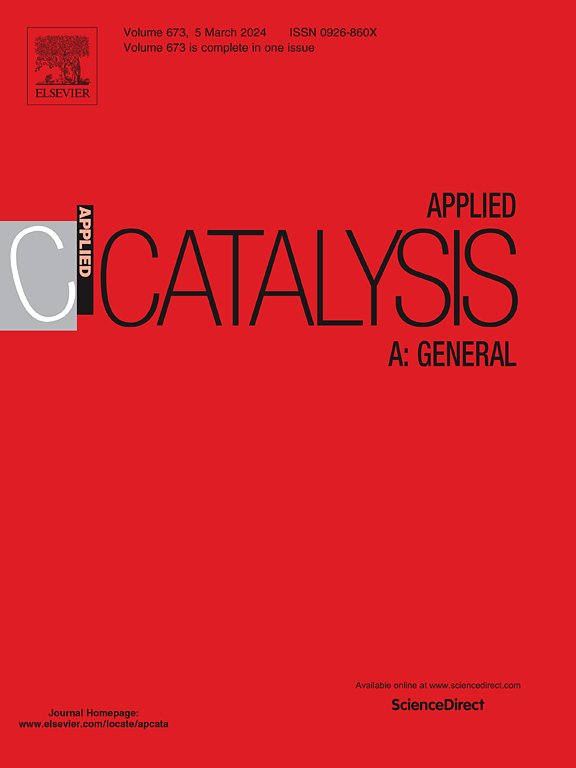温和反应条件下Cu-SnS2-sv@GO纤维素水解产物制乳酸的机理探讨
IF 4.7
2区 化学
Q2 CHEMISTRY, PHYSICAL
引用次数: 0
摘要
纤维素基材料的增值需要克服葡萄糖异构化为果糖的能量屏障。然而,该过程往往依赖于高温和苛刻的热催化条件。本研究开发了6种 %Cu-SnS2-sv@GO气凝胶作为酶预处理微晶纤维素制备乳酸的催化剂。这些气凝胶表现出优异的热催化和光催化性能。Cu的参与显著提高了催化剂的Lewis酸度和总酸度,从而提高了热催化效率。值得注意的是,该催化剂在相对较低的温度下促进了葡萄糖异构化成果糖,反应在40℃左右开始。此外,Cu掺杂调节了催化剂的能带结构,增强了其光吸收性,提高了光致电子-空穴对的分离效率。单次热催化过程中产生的果糖由于其缓慢的转化率而积累。相反,积累的果糖在热光催化过程中被有效地消耗掉,显著提高了乙酰丙酸(LA)的选择性和产率。在合成的催化剂中,6 %Cu-SnS2-sv@GO表现出最高的性能,在80°C下,在2 小时的可见光照射下,达到了83.6 %的最佳LA产率(基于酶解产物)。这些发现为纤维素基材料的高价值利用提供了一种新颖而有效的策略。本文章由计算机程序翻译,如有差异,请以英文原文为准。
Mechanism exploration of Cu-SnS2-sv@GO during the process of converting cellulose hydrolysate to lactic acid under mild reaction conditions
Valorization of cellulose-based materials requires overcoming the energy barrier of glucose isomerization to fructose. However, the process is often reliant on high temperatures and harsh thermal-catalytic conditions. In this study, 6 %Cu-SnS2-sv@GO aerogels were developed as catalysts to produce lactic acid (LA) from enzyme-pretreated microcrystalline cellulose. These aerogels demonstrated remarkable thermo-catalytic and photocatalytic performances. The participation of Cu significantly enhanced the Lewis acidity and the total acidity of the catalyst, thereby boosting thermo-catalytic efficiency. Notably, the catalyst facilitated glucose isomerization to fructose at relatively low temperatures, with the reaction launching around 40 °C. Furthermore, Cu doping modulates the band structure of the catalyst, enhancing its light absorbability and improving the separation efficiency of photoinduced electron-hole pairs. Fructose produced during the single thermo-catalysis process accumulates due to its slow conversion rate. In contrast, the accumulated fructose is effectively depleted during thermo-photocatalysis, significantly enhancing both the selectivity and yield of levulinic acid (LA). Among the synthesized catalysts, 6 %Cu-SnS2-sv@GO demonstrated the highest performance, achieving an optimal LA yield of 83.6 % (based on the enzymatic hydrolysate) at 80 °C under 2 hours of visible-light irradiation. These findings present a novel and efficient strategy for the high-value utilization of cellulose-based materials.
求助全文
通过发布文献求助,成功后即可免费获取论文全文。
去求助
来源期刊

Applied Catalysis A: General
化学-环境科学
CiteScore
9.00
自引率
5.50%
发文量
415
审稿时长
24 days
期刊介绍:
Applied Catalysis A: General publishes original papers on all aspects of catalysis of basic and practical interest to chemical scientists in both industrial and academic fields, with an emphasis onnew understanding of catalysts and catalytic reactions, new catalytic materials, new techniques, and new processes, especially those that have potential practical implications.
Papers that report results of a thorough study or optimization of systems or processes that are well understood, widely studied, or minor variations of known ones are discouraged. Authors should include statements in a separate section "Justification for Publication" of how the manuscript fits the scope of the journal in the cover letter to the editors. Submissions without such justification will be rejected without review.
 求助内容:
求助内容: 应助结果提醒方式:
应助结果提醒方式:


